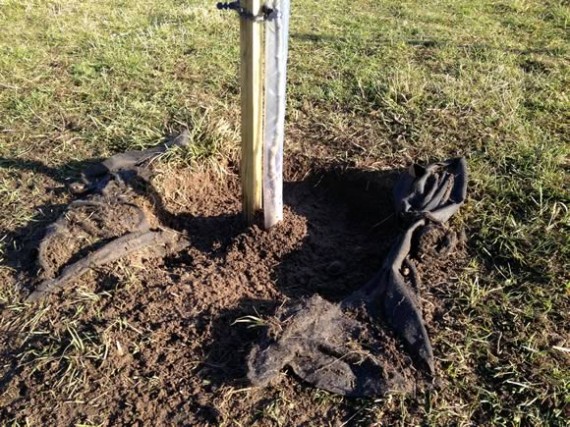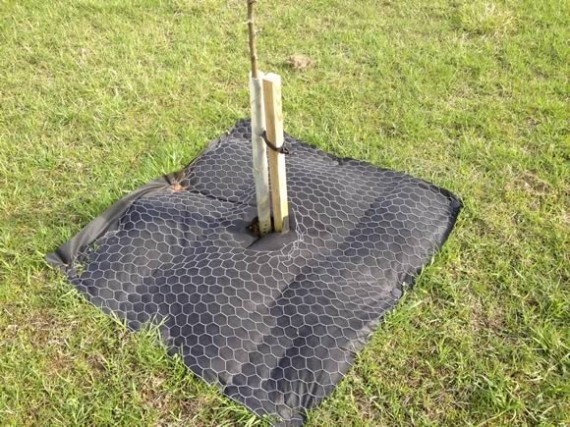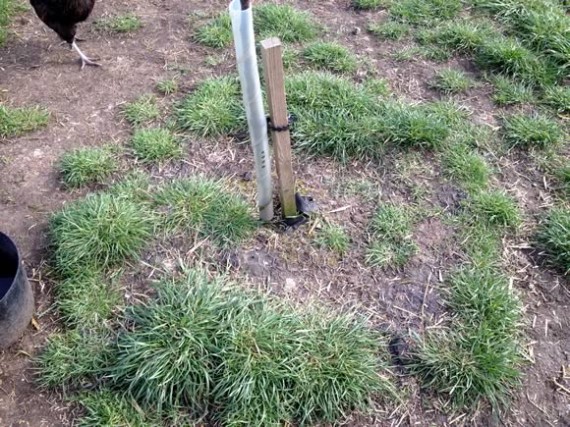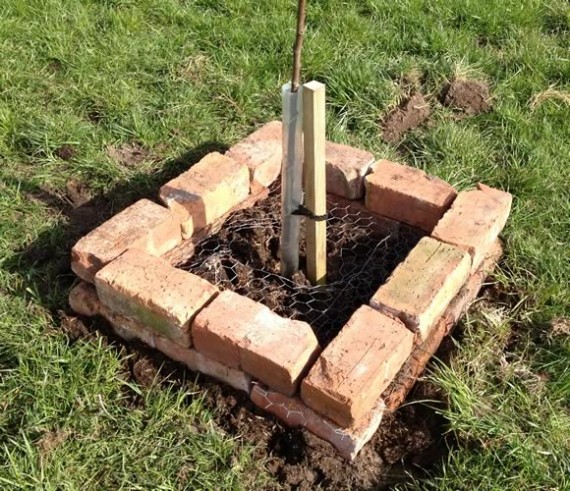Posted: Thursday 2 May, 2013
In early spring 2012 we planted about 60 apple trees as the first part of our orchard. The orchard is also home to our laying flocks of hens - about 80 hens in all, split into two flocks - the idea being that we get double use from the land, the hens fertilise the ground, take care of a lot of pests, and will eventually benefit from the cover the trees provide.
One of the challenges we faced was how to protect the young trees as they grow. To give young apple trees the best possible start you need to keep an area of at least 1m in diameter clear of grass - otherwise the grass competes with the shallow roots for nutrition, and if left unchecked will stunt and in extreme cases kill the tree.
So we wanted a solution that was reasonably cheap and easy to maintain (at least once a year we need to clean up around the base of the tree, add an organic mulch and possibly some growmore). We also need to cut the grass a couple of times in the summer since it grows faster than the hens can eat it.
Our first attempt involved a circle of weed suppressing fabric, pegged evenly and securely. It didn't end well!
 Weed suppressing fabric alone is not hen proof!
Weed suppressing fabric alone is not hen proof!
Clearly the hens were harder on it than we'd expected, so we modified the idea by covering the fabric with a layer of chicken wire (we also moved to squares - far less work!):
 Adding wire makes it hen proof and it looks smart
Adding wire makes it hen proof and it looks smart
While this did a great job of dissuading the hens from scratching around the base of the tree, after a couple of months the grass had grown through the edges of the chicken wire and in some places through the fabric itself:
 But grass quickly grows through wire making it hard to maintain
But grass quickly grows through wire making it hard to maintain
This made it difficult to lift, and impossible to do so without bending it all out of shape, and in some cases the wire had to be cut.
We've now moved on to a third idea, courtesy of the old man - a double course of bricks with the chicken wire located between the two:
 Our latest design - a lot prettier and hopefully more usable.
Our latest design - a lot prettier and hopefully more usable.
We had the bricks already, from an old brick path that we lifted when doing some work on our drive. This will hopefully do everything we need:
- It's easy to cut around, and we can strim up to the hard edge;
- The hens are defeated by it;
- It's dead easy to lift a few bricks, lift the wire and do any required weeding, or replace the mulch;
- It also looks smart!
Time will tell whether it's entirely effective - we'll know by the end of June!
- Previous « Helping the grass grow
- Next New pen for meat birds »
Comments
Duncan
We've done the same setup - new orchard, small flock of chickens. I've found that if the dirt is left bare, then the chickens just scratch the top inco or so and tend to prevent any grass build up anyway. What little grass that does grow is easily pulled out when doing the general maintenance. We also mow the orchard (the trees are too small for geese to be introduced yet) and the clippings go around the base of the tree, forming a temporary mulch layer, supressing growth and keeping moisture in. Of course, the chickens get to it eventually, but this has all seemed to work over the last two years just fine for us, enough time for the trees to grow. In a year or so, when the trees are well and truly established we'll let the grass grow up to them anyway, or plant wild garlic bulbs under each one.
Duncan
I should have said, the orchard section on mm106 rootstock is only a quarter acre in size and there are around 10 chickens on that. They also have a larger oak tree they tend to like sunbathing beneath, so that may help us.
Dan
Our hens must be harder scratchers than your's Duncan! I've found that they just keep scratching, damaging the shallow roots and exposing more of the root system than I'm happy with, especially in winter. They also destroy any sort of mulch very quickly, so we need some kind of physical barrier.
Edwina
Using a double course of old bricks to form a decorate feature with a practical purpose is a great idea! I may have to give this a try myself as I too am keen to grow my own apple trees - thanks for the tip!
Tim Daniels
Hello Dan,
I recently moved my flock onto about 1/4 acre of grass which is very exposed to the south-westerly winds and offers little protection to my birds during wet and windy weather.
I decided to plant a small orchard within this new run. Poultry like some overhead protection from predators anyway and I hope when larger the trees will provide some protection from the elements too.
After digging out a large hole and filling it with topsoil and well rotted horse manure, taking great care with my planting, like you, I suddenly realised the chickens were going to scratch it all out again!
I ended up creating circular rings of wire mesh to stop the chickens but also to stop the geese from picking at the trees.
You can see a photo of it in my blog post here: https://poultrykeeper.com/blog/creating-a-poultry-orchard/
It's the last photo...
All the best. Tim.
Stephen
Whilst bricks probably look more decorative, when living in Namibia we used to surround our trees and shrubs with cement rings - the types used for main drains which lock together to form a pipe.
At about a metre in diameter, they provided both protection to the sapplings and a sufficiently large grass-free area to ensure the roots did not have to compete for nutrients.
However, the main advantage was that they were watertight which meant that when watering the tree or bush none of the water eascaped over the grass. Obviously in a desert country this was an important feature which, unless cemented together, bricks cannot compete with.
theplumberatwork
I have found that if you dig the hole a little bigger, when you have planted your tree and filled in most of the soil, put an old car tire over the tree and push into the soil about 50mm, thats two inches in old money, you then can fill the inside of the tire with stones, when you water your new tree the water stays around the tree, and the stones help with evaporation and weeding. And when you need to strim or get close with a mower, no damage to tree or machinery, also I only visit my plot six or seven times a year and I have no rabbit damage at all.
broomehill
There is no need to peg a mulch mat down as you seem to have done before you turned to bricks and wire. If you place your spade blade about 4 inches from the edge of the mat and just press it down into the ground about an inch or so and do this all the way round the mat, you will find it just anchors itself into the ground, turning itself in neatly. I spent ages unsuccessfully pegging down mulch mats until someone wised me up to this trick. Likewise if you are mulching a line of new hedging with mulch strip, just run along the edge of the strip and tuck it in with the spade. You will quickly find that you do need to leave a little slack in you placement of the mat so that the enough to tuck down! Surprisingly, the spade doesn't seem to cut the mat. How are the fruit trees doing?
Dan
The trees are doing well broomehill, thanks. :-)
The problem we had with wire wasn't the pegs so much as the grass growing through the wire and making it nigh on impossible to lift for effective weeding. I suppose we could have just left it there and mulched over it, but that just feels wrong. :-)
We're very happy with the stone and wire solution we're now using, and once the trees are established it will be easily removed to allow grassing right up to the trunks.
vince wakefield
Interesting views, I do like the tyre filled with stones, A small observation of your staking if you don't mind, With the position of your tie you run the risk of the tree rubbing against top of the post when its windy and damaging the bark, this can lead to infection. I always put the tie at the top of the stake to prevent this, if the tree is very small when planted i may put on 2 ties, one at the correct height to support the tree and another at the top to stop rubbing, Later when the tree has grown a bit just use the top tie.
Comments are now closed for this post.









bluecat
Thursday 2 May, 2013 at 8:31pm
I've read that hens apparently won't cross through a lavender hedge - so you could surround the trees with small lavender plants. You'd need the bricks until the plants have grown - but then you'd have triple use of your land. If it works, mind you.